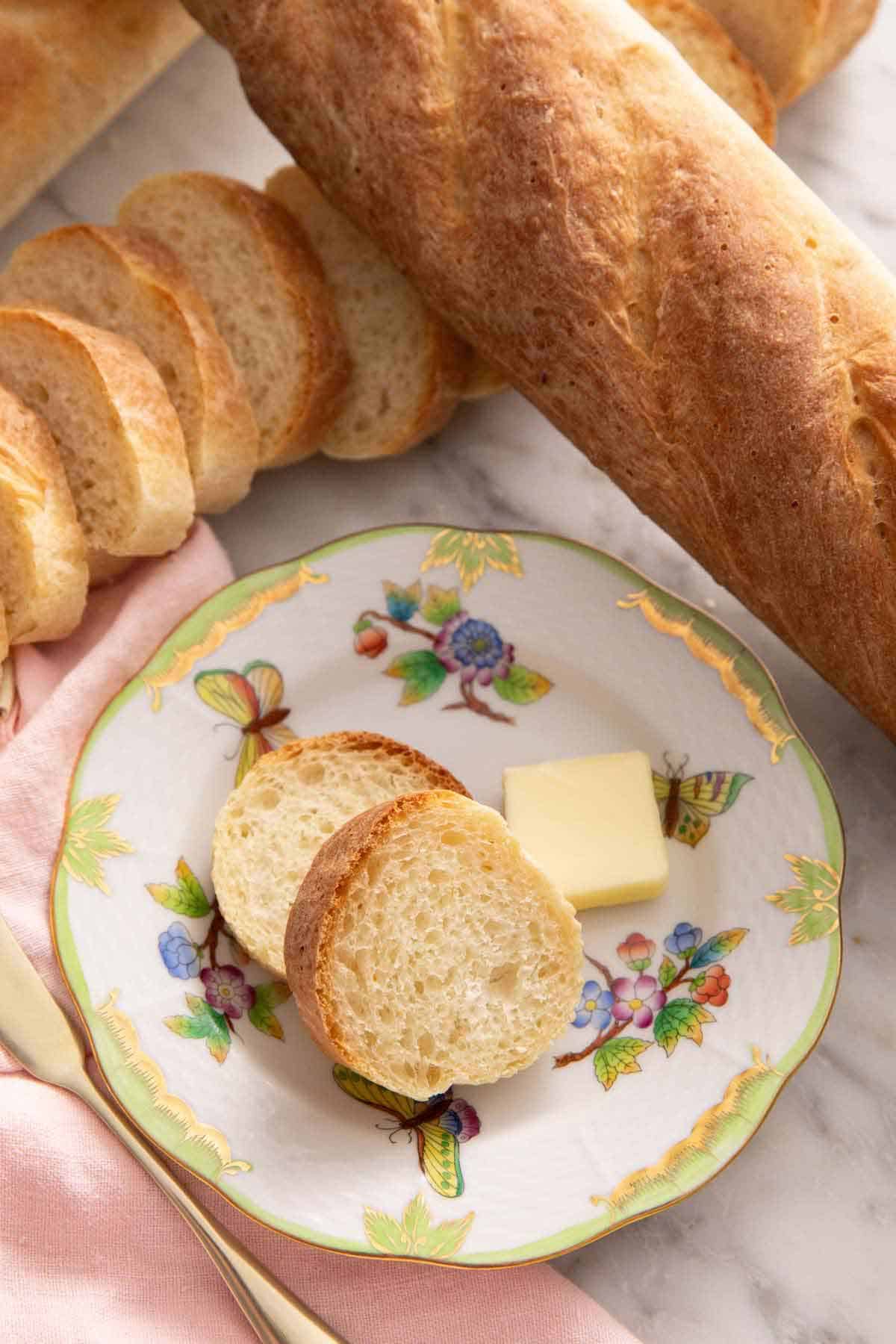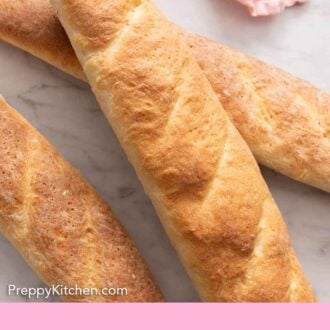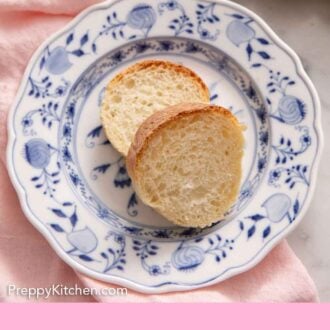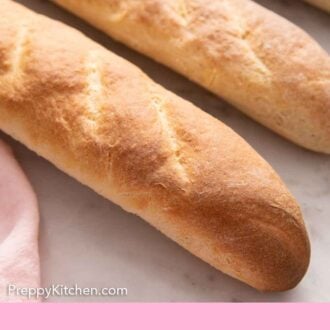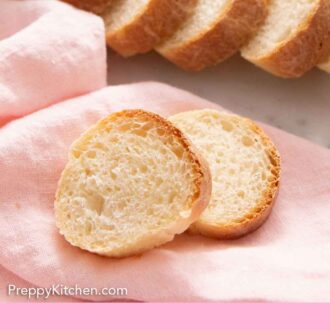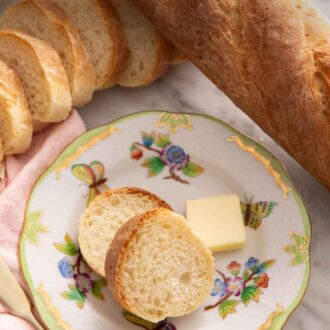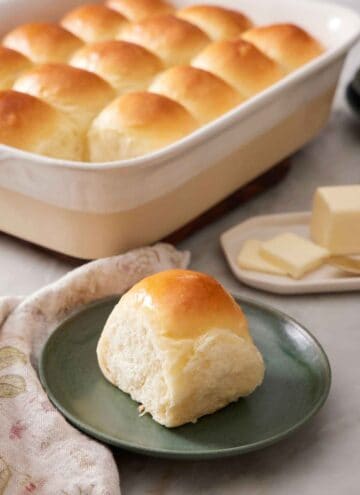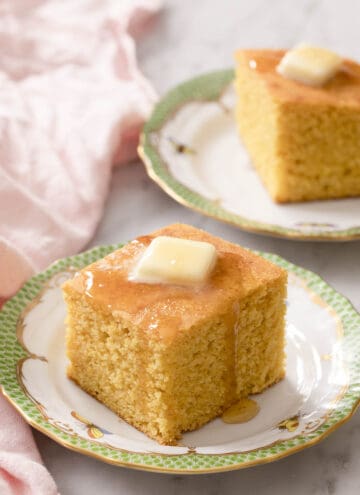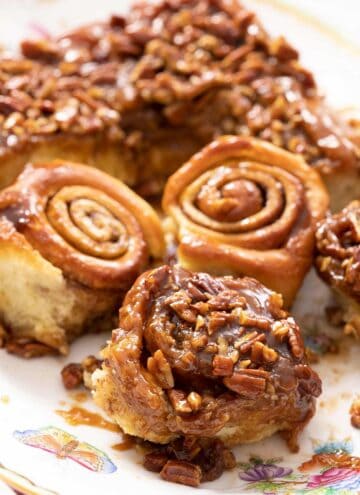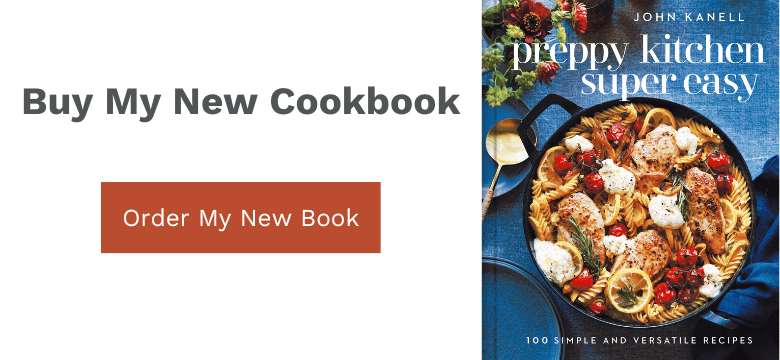Fresh bread is so much easier to make than you think, and my French bread recipe is even simpler than most! The majority of the prep time is spent waiting for the dough to rise beautifully, so it’s a very hands-off recipe made with just a few pantry staples.
This French bread recipe is best saved for a time when you have a couple of hours to spend at home. It bakes up pretty fast into two loaves with a soft crumb and golden brown crust, perfect for slicing and smearing generously with butter, or dunking into soup! For more homemade bread recipes, try out my garlic bread recipe, homemade naan recipe, and artisan bread recipe.
What You Need to Make this Recipe
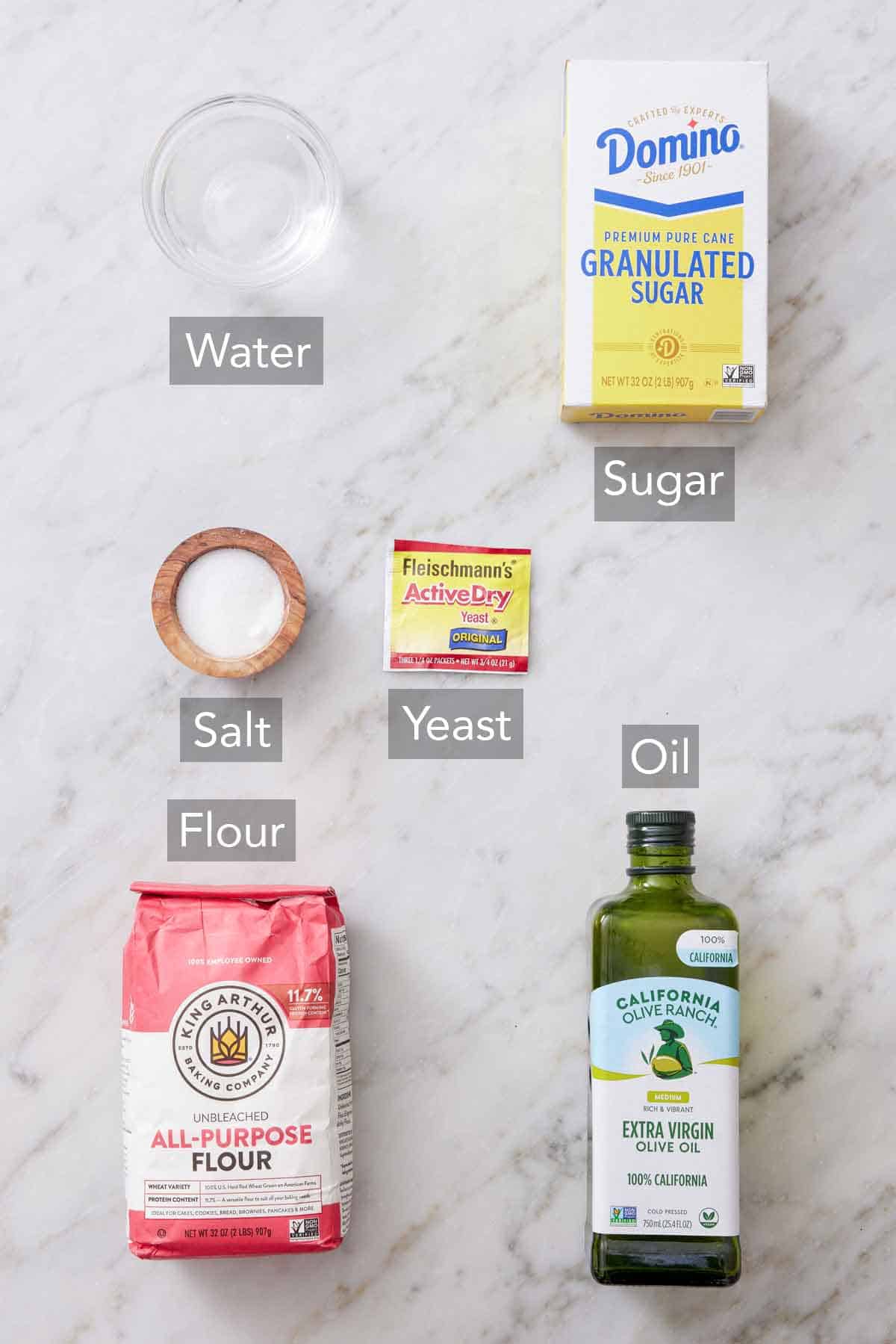
Water and sugar — warm water and granulated sugar activate the yeast.
Active dry yeast — yeast helps the dough rise. Active dry yeast is not the same as rapid-rise or instant yeast, though you can also use those. See my pro tips for how to make the swap.
Flour — all-purpose flour and bread flour both yield a delicious soft crumb, so use whichever you have on hand.
Sea salt — not only does salt add flavor to the bread, but it also strengthens the dough.
Olive oil — oil hydrates and tenderizes the bread dough. It also keeps the dough from sticking to the bowl during the first rise.
How to Make French Bread
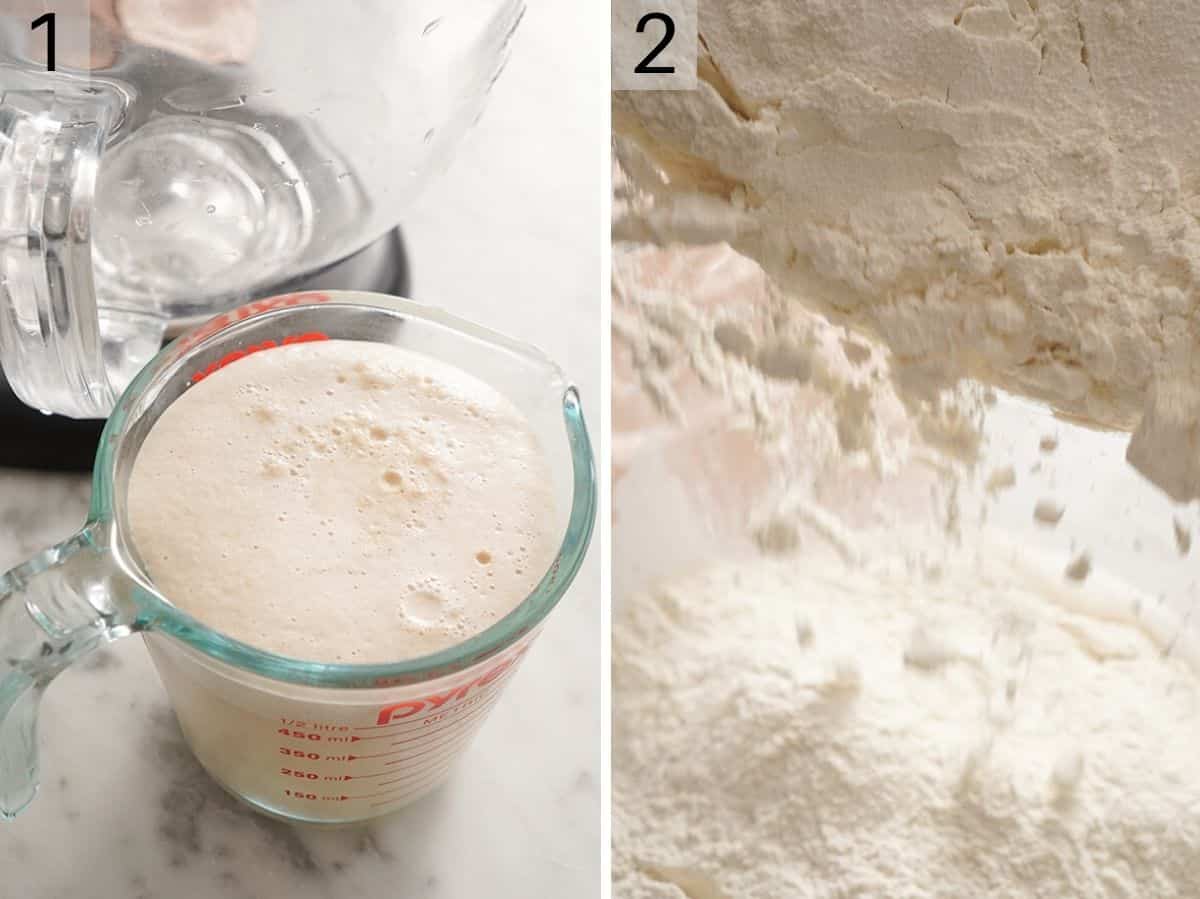
1. Stir together the warm water, sugar, and yeast in the bowl of a stand mixer, and set aside for about 5 minutes or until very foamy.
2. Add 3 cups of all-purpose flour or bread flour to the yeast mixture along with the olive oil and salt and bring together with a spatula.
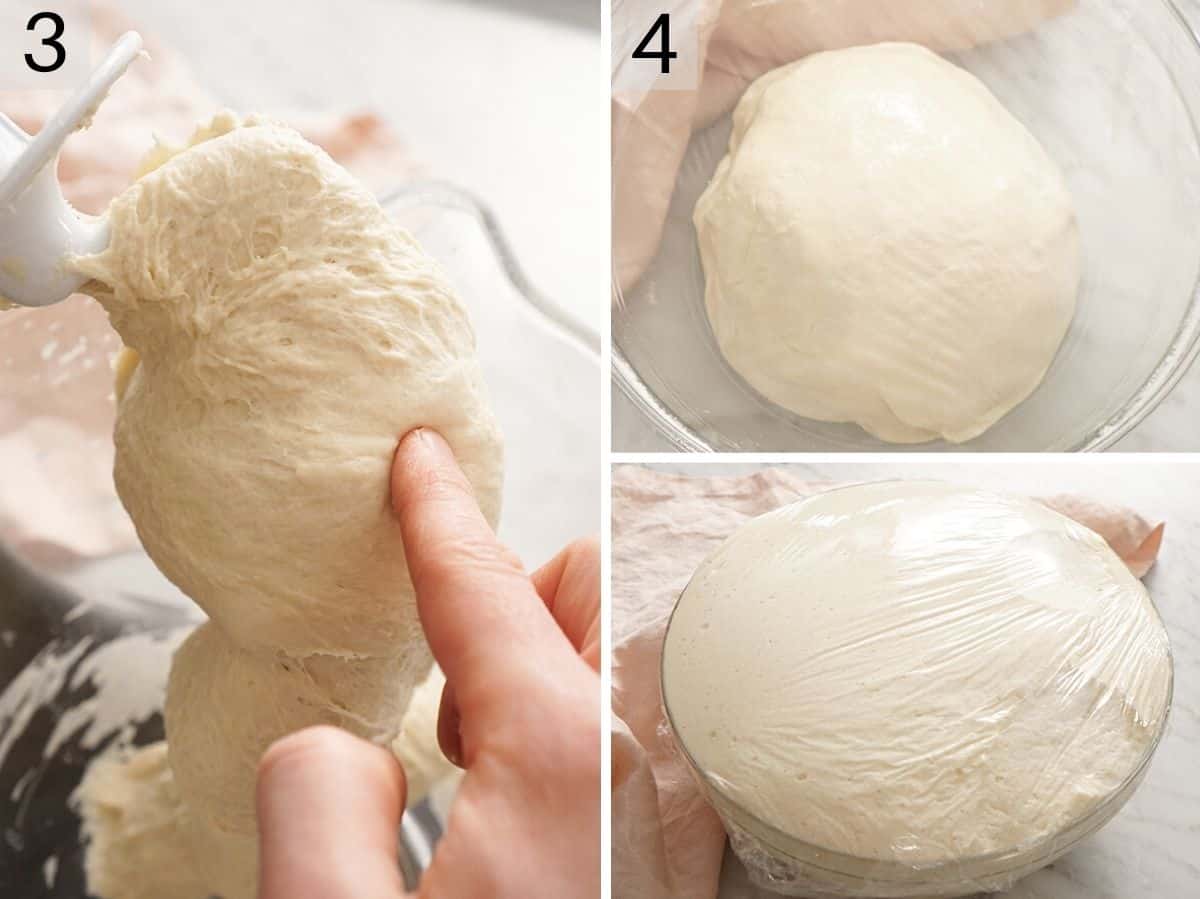
3. Begin mixing on medium-low speed with the dough hook attachment. Add the remaining flour ½ a cup at a time. Increase the speed to medium and knead until the dough comes together in a ball, which will take 2 to 3 minutes. The dough should pull away from the sides of the bowl, spring back when pressed, and not stick to your finger. It should also feel quite soft. Add additional flour a few tablespoons at a time if needed (if the dough is too sticky).
4. Transfer the dough to a lightly oiled large bowl, cover with plastic wrap, and place in a warm place to rise until doubled in size. This usually takes about an hour, but will depend on the temperature of your kitchen.
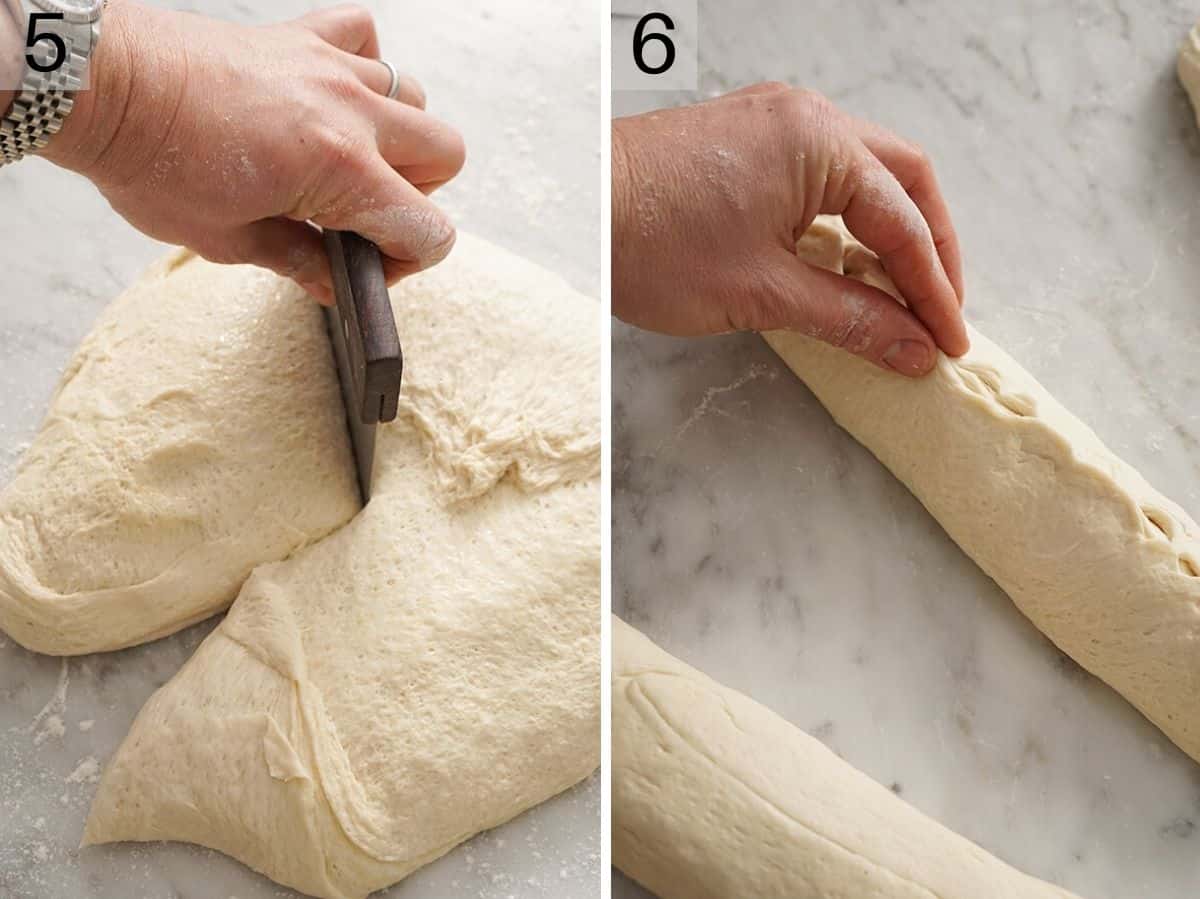
5. Turn the dough onto a lightly floured surface. Divide the dough in half.
6. Shape each half into roughly a 9×12-inch rectangle. Starting on one long side, roll the dough like a jelly roll into a cylinder.
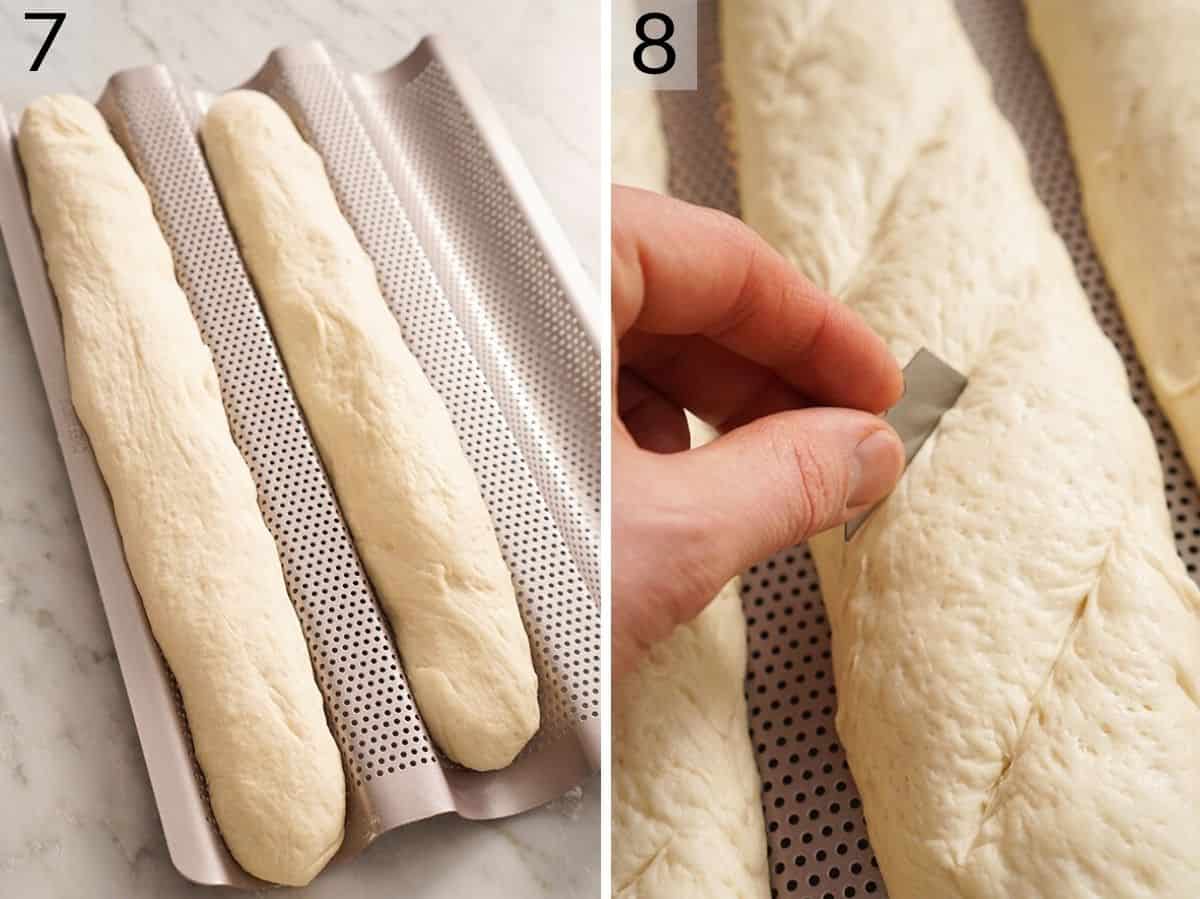
7. Line a baking sheet with parchment paper and place the loaves on the pan. Loosely cover and allow the dough to rise once more until the dough is very visibly puffed, 30 to 40 minutes. This is called proofing the dough. After the loaves have risen for 20 minutes, preheat the oven to 375°F so it is heated up and ready once the dough has risen completely.
8. Cut 3 to 4 diagonal slashes on top of each risen loaf using a bread lame (metal razor blade) or very sharp knife. Scoring the dough like this is not just for aesthetics; the slashes help control how the dough expands. So don’t skip this step! Bake the loaves in the hot oven for 25 to 30 minutes or until golden brown and the loaves sound hollow when you tap on them.
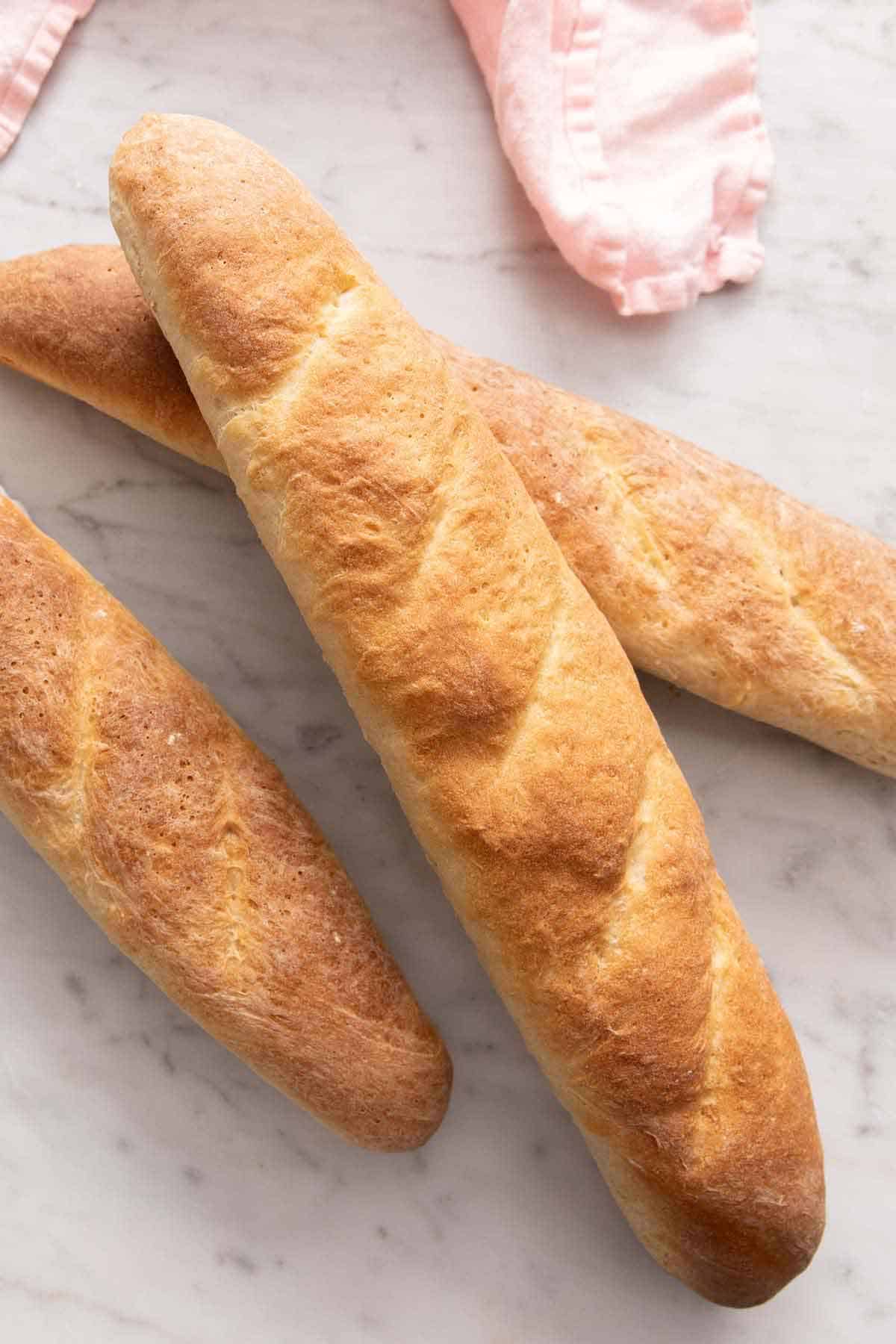
Pro Tips for Making this Recipe
- Add flour a little at a time to achieve the perfect soft dough. After adding the initial 3 cups of flour, add a little bit at a time as you knead (or while the dough hook works its magic) until you have a soft, springy dough that is not sticky. Depending on the brand of flour you use, how you measure your ingredients, and the humidity when making the bread, you may need more or less flour.
- Make sure your water is not too hot. The water should be warm (around 110°F), not hot, or it will kill the yeast, and your bread won’t rise.
- The dough rise time depends on your kitchen temperature. Don’t place the dough in direct sunlight or in an area that’s too hot, or it can over-proof. If your kitchen is warm (70-75°F), just leave it on the counter. If it’s cool, turn the oven light on and place it in the oven (make sure it’s off and cool). The light will add enough ambient warmth to create a suitable rising environment for the dough.
- Score the loaves before baking. Slashing the proofed dough diagonally 3 or 4 times will control how the bread expands and allow the loaves to keep their shape as they bake.
- For a nice crisp crust, you need to create some steam. Place a pan on the lower rack near the bottom of the oven before you turn it on to preheat. Then, after you add the bread to the oven, pour ¾ cup of hot water into the lower-rack pan. Do not open the oven door while the bread bakes until you think it’s done. The bread will be delicious if you skip this, but it’s a bakery trick that I love to use for my loaves.
- For smaller loaves: Divide the dough into thirds or fourths before shaping, keeping in mind the rectangles will also be smaller for shaping, and the bake time will be 5 to 10 minutes less.
- For more perfectly cylindrical loaves, use a baguette pan! You can order them online or purchase them in specialty kitchen supply stores.
- For a faster rise time, use instant yeast. Rapid-rise yeast or instant yeast activates and rises faster than active dry yeast. It also doesn’t need to bloom in warm water. If you want to make the swap to one of these fast-acting varieties, simply skip step 1, whisk the yeast and sugar into the flour, add the water, oil, and salt, and continue as directed.
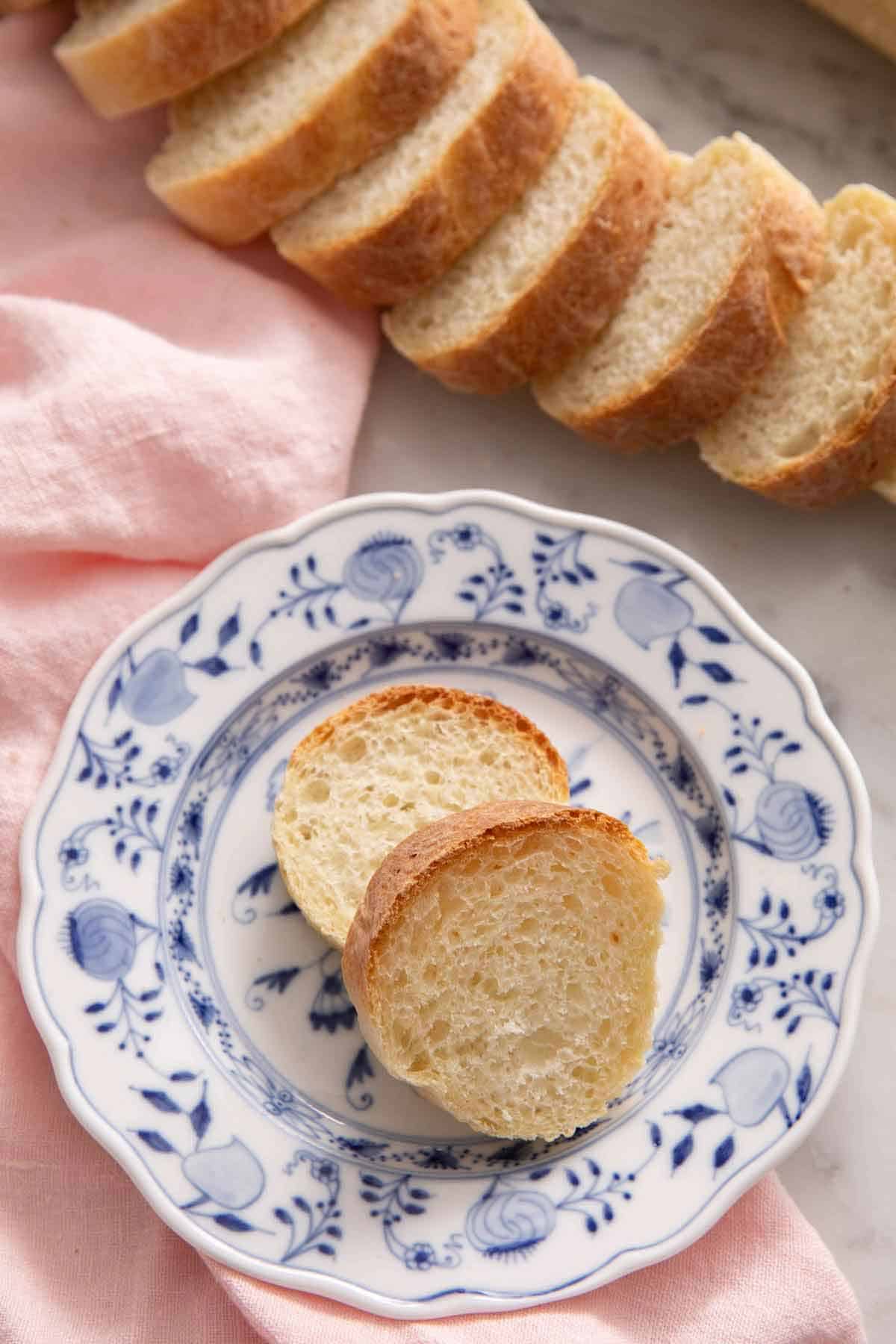
Frequently Asked Questions
While very similar, they are not the same. French bread is a little wider and shorter than a baguette. Baguettes also have a much crisper crust and a more open texture inside.
French bread takes 25 to 30 minutes to bake at 375°F. All ovens are different, however, so you can also check for doneness by making sure the bread is golden brown. Additionally, it should sound hollow when you tap it. For an even more precise measurement, insert and instant-read thermometer into the center and pull it from the oven when it reaches and internal temperature of 195°F.
French bread is so versatile! It’s delicious, served warm with a spread of butter, dunked into soups, beef stew, slow cooker chili, turned into garlic bread, or sliced and toasted to make my bruschetta recipe! You can even use it to make sandwiches.
French loaves will keep in an airtight container or ziptop bag, or even wrapped in aluminum foil, for about 2 to 3 days. You can eat it at room temperature or warm it up in the oven.
Yes, this bread freezes really well. Once the loaves cool completely to room temperature, wrap them individually in plastic wrap and then a layer of foil and freeze for up to 2 months. Thaw completely before serving. I like reheating the bread in the oven so the crust crisps up again.
If you’ve tried this French bread recipe, then don’t forget to rate the recipe and let me know how you got on in the comments below, I love hearing from you!
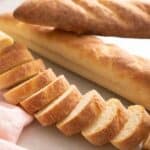
French Bread
Video
Equipment
- Stand mixer
- mixing bowl
- Baking Sheet
Ingredients
- 2 cups warm water (about 110°F) (480ml)
- 2 tablespoons granulated sugar
- 1 tablespoon active dry yeast
- 5½ cups all-purpose flour or bread flour (660g)
- 1½ teaspoons sea salt
- 1 tablespoon olive oil
Instructions
- In the bowl of a stand mixer, stir together the warm water, sugar, and yeast, and set aside for about 5 minutes or until very foamy.
- Add 3 cups of flour to the mixture along with the oil and salt and stir together with a spatula, then begin mixing with the dough hook on medium-low speed. Add the remaining flour a half cup at a time. Increase the speed to medium and knead until the dough comes together in a ball, 2 to 3 minutes. The dough should pull away from the sides of the bowl, spring back when pressed, and not stick to your finger. Add additional flour a few tablespoons at a time if needed.
- Transfer to a lightly oiled large bowl, cover with plastic wrap, and place in a warm place to rise until doubled in size, about an hour.
- Turn the dough onto a lightly floured surface. Divide it in half and shape each half into roughly a 9×12-inch rectangle. Starting on one long side, roll the dough like a jelly roll into a cylinder. Line a baking sheet with parchment paper and place the loaves on the pan. Loosely cover and allow to rise once more until very visibly puffed, 30 to 40 minutes.
- After the loaves have risen for 20 minutes, preheat the oven to 375°F. (See Tips about how to bake loaves with a crisp crust.)
- Cut 3 to 4 diagonal slashes on top of each risen loaf using a bread lame or very sharp knife.
- Bake for 25 to 30 minutes or until golden brown and the loaves sound hollow when you tap on them.
Notes
- Add flour a little at a time to achieve the perfect soft dough. After adding the initial 3 cups of flour, add a little bit at a time as you knead (or while the dough hook works its magic) until you have a soft, springy dough that is not sticky. Depending on the brand of flour you use, how you measure your ingredients, and the humidity when making the bread, you may need more or less flour.
- Make sure your water is not too hot. The water should be warm (around 110°F), not hot, or it will kill the yeast, and your bread won’t rise.
- The dough rise time depends on your kitchen temperature. Don’t place the dough in direct sunlight or in an area that’s too hot, or it can over-proof. If your kitchen is warm (70-75°F), just leave it on the counter. If it’s cool, turn the oven light on and place it in the oven (make sure it’s off and cool). The light will add enough ambient warmth to create a suitable rising environment for the dough.
- Score the loaves before baking. Slashing the proofed dough diagonally 3 or 4 times will control how the bread expands and allow the loaves to keep their shape as they bake.
- For a nice crisp crust, you need to create some steam. Place a pan on the lower rack near the bottom of the oven before you turn it on to preheat. Then, after you add the bread to the oven, pour ¾ cup of hot water into the lower-rack pan. Do not open the oven door while the bread bakes until you think it’s done. The bread will be delicious if you skip this, but it’s a bakery trick that I love to use for my loaves.
- For smaller loaves: Divide the dough into thirds or fourths before shaping, keeping in mind the rectangles will also be smaller for shaping, and the bake time will be 5 to 10 minutes less.
- For more perfectly cylindrical loaves, use a baguette pan! You can order them online or purchase them in specialty kitchen supply stores.
- For a faster rise time, use instant yeast. Rapid-rise yeast or instant yeast activates and rises faster than active dry yeast. It also doesn’t need to bloom in warm water. If you want to make the swap to one of these fast-acting varieties, simply skip step 1, whisk the yeast and sugar into the flour, add the water, oil, and salt, and continue as directed.



